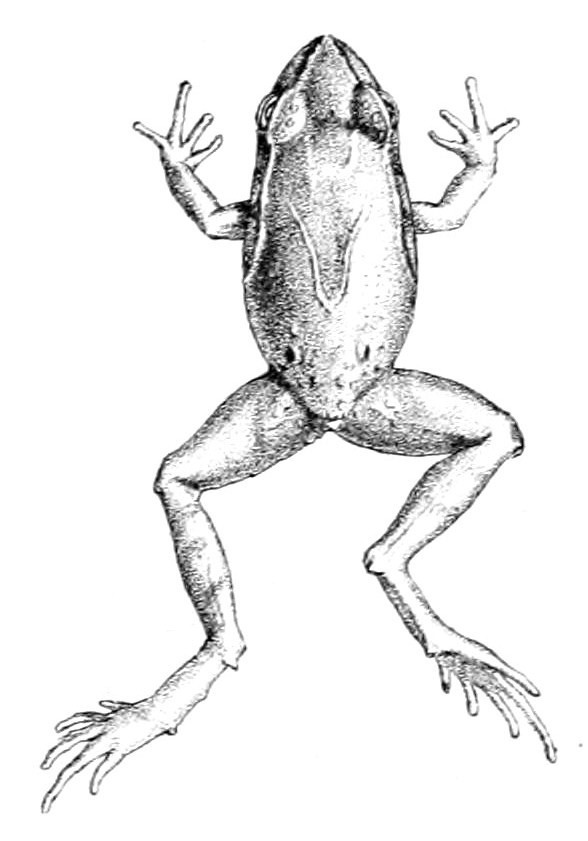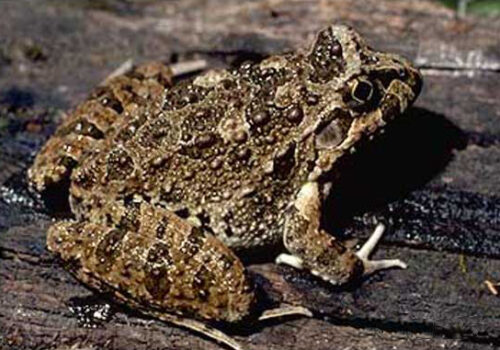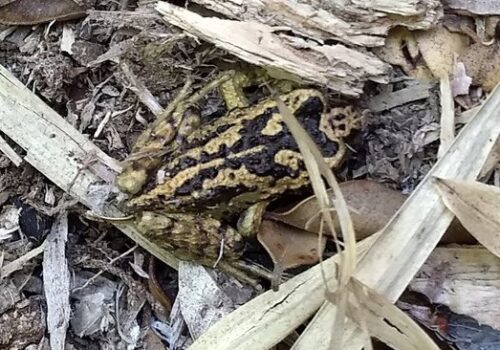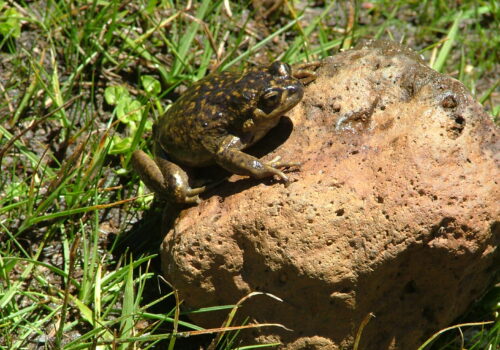- Eupsophus calcaratus: Unveiling the Secrets of Chile's Hidden Spiny-Chest Frog
- Taxonomy and Classification
- Natural Habitat: A Rainforest Dweller in the shadows
- Physical Characteristics: A Master of Camouflage and Subtlety
- Behavior and Life Cycle: Secretive Habits of a Mysterious Forest Frog
- Ecological Role: Valuable Indicator and Ecological Regulator
- Threats and Conservation Status: Fragility in the Face of Modernity
- Cultural and Scientific Significance: Hidden Gems within Biodiversity Research
- Conclusion: A Call to Cherish Chile's Forest Frogs
Eupsophus calcaratus: Unveiling the Secrets of Chile’s Hidden Spiny-Chest Frog#
Beneath the dense, humid canopy of the temperate rainforests in southern Chile exists an amphibian whose quiet presence can easily be overlooked, even by the keen eyes of nature enthusiasts. With soft reddish-brown skin, cryptic markings, and a shy demeanor, Eupsophus calcaratus, commonly known as the Spiny-Chest Frog, is as mysterious as it is intriguing. Though unassuming at first glance, this little-known amphibian holds keys to understanding ecosystem health, unique evolutionary adaptations, and the delicate balance of southern South America’s rich biodiversity.
Named for distinctive bony spurs present on males, Eupsophus calcaratus is part of the family Alsodidae—a family unique to southern South America. Despite being relatively obscure among casual naturalists, the species appeals to passionate herpetologists and environmentalists due to its fascinating biology, intriguing behaviors, and important ecological role.
Join me on a journey through southern Chile’s mist-laden forests as we uncover the hidden lives, biology, and conservation concerns of Eupsophus calcaratus, the enigmatic Spiny-Chest Frog.
Taxonomy and Classification#
Eupsophus calcaratus belongs to the Alsodidae family, which is exclusive to the southern regions of South America. Alsodidae are predominantly terrestrial frogs known for their specialized adaptations to moist, temperate forests. Within this family, the genus Eupsophus comprises several closely related species—many of which share similar cryptic coloration, behavior, and habitat preferences.
The species name “calcaratus” is derived from Latin, meaning “spur-bearing,” referencing the conspicuous bony spurs found on adult males. These spurs are among the defining characteristics used by scientists to identify and classify this particular species, especially during breeding periods.
Natural Habitat: A Rainforest Dweller in the shadows#
Eupsophus calcaratus inhabits a narrow distribution range primarily within southern Chilean forests, especially between the Maule Region and Los Lagos Region. Here, amidst lush temperate rainforests carpeted with moss-covered logs, thick ferns, and the soft crunch of leaf litter, the Spiny-Chest Frog finds optimal conditions crucial to its survival.
Unlike many amphibians known for frequent water activity, Eupsophus calcaratus is predominantly terrestrial, favoring moist, shaded soils near swift-flowing streams or gently trickling rivulets. It is an expert at escaping human detection, camouflaging easily amidst fallen leaves and decomposing wood. Its spotted and mottled coloration blends seamlessly into forest floors dappled with dim sunlight piercing through the dense canopy above.
The cooler temperatures, abundant rainfall, and high humidity provide an ideal environment where this species can maintain skin moisture—an essential condition that aids in respiration and overall physiological functions. Its narrow environmental tolerance highlights the inherent fragility of the species, making habitat preservation particularly important.
Physical Characteristics: A Master of Camouflage and Subtlety#
Physically unassuming but beautiful when closely examined, the Spiny-Chest Frog is a relatively small species averaging 3 to 4 centimeters in length. The head is slightly rounded, and the limbs robust and adapted for terrestrial movement. Dorsal coloration often ranges from subdued reddish-brown to darker hues of chocolate or gray, punctuated by subtle darker spots or stripes, further aiding in its camouflage.
Notably, adult males possess an intriguing anatomical feature that inspired its common name: a pair of hardened, spur-like projections protruding from the chest, used primarily during courtship rivalries. When confronted by rival males in competitive displays, these small yet formidable spurs confer an advantage, deterring rivals and demonstrating fitness to potential mates.
The frog’s eyes, large comparatively to its slender frame, grant it impressive low-light vision, essential for nocturnal hunting expeditions. Long digits tipped with small pads help them navigate effortlessly through layered leaf litter and uneven forest terrain, silent and purposely hidden from predators lurking in nearby foliage.
Behavior and Life Cycle: Secretive Habits of a Mysterious Forest Frog#
Nocturnal Foraging and Diet#
Nightfall signals the beginning of activity for Eupsophus calcaratus. This species emerges from daytime hiding spots beneath logs or within hidden burrows, venturing forth in search of nourishment. Insects, small arthropods, spiders, and worms constitute the bulk of its diet. Advanced sensory capabilities allow the frog to detect even minor vibrations or movements beneath detritus and leaf litter, swiftly capturing its prey with a sudden leap or stealthy approach.
Mating Rituals and Parental Care#
One of the most captivating aspects of the Spiny-Chest Frog’s behavior lies in its fascinating breeding strategies. Unlike many amphibians that rely heavily on sizable bodies of water, Eupsophus calcaratus engages in terrestrial reproduction. During rainy seasons between spring and early summer, males vocalize to attract females, their calls—a series of distinctive chirps and short clicks—creating nighttime music through the darkened woods.
Females carefully select males based on vigor, territory quality, and acoustic qualities of their calls. After mating, rather than laying eggs directly into streams or ponds, females deposit eggs within hidden terrestrial burrows or under moist vegetation. Uniquely, male Spiny-Chest Frogs demonstrate noteworthy parental involvement, often guarding and attending developing eggs, maintaining humidity and protecting their progeny from would-be predators or fungal infections.
Once hatched, tadpoles must journey to nearby water sources to complete their development—occasionally facilitated or protected on their passage by vigilant fathers. This dedication to offspring care is considered an evolutionary adaptation allowing greater survival rates, essential within uncertain terrestrial environments.
Ecological Role: Valuable Indicator and Ecological Regulator#
Within its delicate southern Chilean habitat, Eupsophus calcaratus fulfills critical ecological functions. As an insect predator, it actively helps to maintain balanced populations of smaller arthropods. Additionally, these frogs form integral links in local food webs, serving themselves as prey for birds, snakes, and small mammals resilient enough to pursue them through the sheltered forest gloom.
Scientifically, amphibians like Eupsophus calcaratus are excellent bioindicators. Due to their susceptibility to environmental perturbations, these frogs can rapidly inform conservationists of ecosystem disturbances or potential environmental pollutants. Monitoring their health can quickly reveal shifts in local ecological balance, alerting researchers to environmental crises, climate-change-induced habitat alterations, or contamination events requiring critical action.
Threats and Conservation Status: Fragility in the Face of Modernity#
While the International Union for Conservation of Nature (IUCN) currently categorizes Eupsophus calcaratus as “Least Concern,” increased pressures threaten their continued security in their natural habitats. Habitat fragmentation and deforestation, driven heavily by forestry, agricultural expansion, and urban development, increasingly encroach upon these frogs’ limited remaining habitats.
Further exacerbating vulnerability, climate change poses a formidable threat by altering rainfall patterns, humidity, and temperature stability—elements critically significant to the survival of moist-forest frogs. Additionally, the global spread of chytrid fungus, a devastating amphibian disease, introduces potential additional risks, underscoring the importance of vigilant research and monitoring.
Protecting remaining habitats, establishing wildlife corridors, and promoting local conservation awareness are crucial strategies essential for safeguarding the Spiny-Chest Frog’s future.
Cultural and Scientific Significance: Hidden Gems within Biodiversity Research#
Though locally obscure, the Spiny-Chest Frog symbolizes the hidden richness contained within Chile’s temperate forests—forests widely recognized amongst conservationists as biodiversity hotspots. Continued research into this species might yield insights beneficial far beyond the realms of basic science, offering understanding and techniques valuable for conservation strategies, climate resilience, or even insights into amphibian physiology applicable elsewhere in the world.
Conclusion: A Call to Cherish Chile’s Forest Frogs#
As we conclude our deep dive into the life and ecology of Eupsophus calcaratus, we recognize a quiet yet significant tale of adaptation, ecological interconnectedness, and vulnerability. Preserving such hidden treasures requires collective environmental awareness and action. We invite readers to both celebrate—and actively advocate—for this delicate yet resilient amphibian species. Only by protecting creatures like the Spiny-Chest Frog can we preserve the intricate tapestry of life within our planet’s precious temperate rainforests.













